2023 Year in Review (Also, a few interior photos of my tiny house, pardon the mess😂)
My life is generally best characterized as small, slow and steady, I suspect a sharp contrast to most. If you're someone primarily interested in a tech oriented accounting you should skip to the last section. What comes before that is fairly comprehensive and even a bit philosophical in nature. I'm mostly writing this for myself so it's chock-full of details most people likely won't be interested in.
Home and Landscape
I live in a 200 sq ft tiny house that doesn't need much in the way of maintenance or improvements. I often make small adjustments to the arrangement of the space.
The more significant work is spent outside managing various aspects of the landscape. My garden has been small to nonexistent the past couple of years but I still end up spending a lot of time with various projects. This year it was transplanting blackberries and then, later, keeping them alive during a bit of early summer drought. Then daily harvesting in July.
In late August after a third extreme rainfall event and increasing run-off damage to our gravel roads I decided to take care of some long over-due maintenance. As I don't have a tractor this was my daily exercise, 1-2 hours a day. When I started I was unsure of the scope of the work. My intent was to start with the most problematic 40 feet of road and if it went well to continue on to another section. That first section went very well and I had it completed in 4 days. I ended up working on the remaining damaged sections through early December. I'd estimate 90 days averaging About 1.5 hours a day. It went very well. Various sections of road and driveway are much improved and the exercise generally felt very good. There's more to do but I'm taking a break now that it's gotten colder and the road is somewhat frozen.
Another fall project was clearing out several years worth of growth around our well house. I live in the woods and love it. I'm not in the habit of aggressively cutting back trees, shrubs, vines unless there's a reason to do so. This fall some new forest critters decided to make their homes in our shed and well house. Wood rats! These are about the size of squirrels but without the fuzzy tails.
I started noticing nests and food caches of acorns and wild grapes appearing in both my shed and the well house. I removed them and started taking steps to remove any sense of comfort my little friends had in these spaces. I decluttered the shed and made a point of just being out there a bit for a week. It's an old shed, somewhat open to the environment. Not sealed off tightly. My strategy worked.
The well house was another situation. Autumn olive bushes, wild grapes and honeysuckle had crept in all around the well house. The thick growth right up to the building was perfect for my friends. Food, cover, and nesting material. I don't spend much time in the well house but check it in the fall to prepare for winter. That's when I discovered my friends had started moving in.
It prompted me to take a closer look at the building and the surroundings. Where previously I'd seen the approaching mini-forest as a welcome wind break and habitat for birds (hummingbirds like to nest in the thick growth) I now had to reckon with the fact that it was also habitat for these new neighbors that were very determined to get inside the building and build nests. I sorted out their various access points and started patching old wood they had chewed through. And during the same couple of weeks I began, reluctantly, cutting back all of the growth of the mini forest. It took about three weeks in total. I cleared the area, patched the walls, sealed the outside of the building around the crawlspace.
A final part of this project was tearing down the original, still attached mini-well house structure that had been built by others many years ago. It still served as cover for our well head and the piping into the well house. I removed that and built a much smaller structure using some salvaged wood and windows. It looks a bit like a tiny A-frame greenhouse. It will serve for this winter and will likely be replaced next year as I suspect that the larger well house is going to need some significant work.
Health
I'm still dealing with some sort of inner ear issue that began with a severe, daylong episode of vertigo in September 2022. Without a doctor I've self diagnosed as some sort of Labyrinthitis. The general cause of that condition is bacterial or viral infection. Treatment seems to be centered on steroid shots and vestibular therapy. Generally the advice is to get on living life and allow the brain to adapt. Over the past 15 months it's gotten better allowing me to do normal day-to-day.
Another symptom is tinnitus which I counter with background audio from the DarkNoise app playing 24/7. I've found a pleasant mix of crickets, creek and frogs helps a lot. The crickets are the key frequency/pattern, the frogs/creek are just there to create a pleasant background.
Other health, once I got past the first three months of intense vertigo I was able to get back to my normal routines of daily dog walks and even short 20-30 trail rides on the bike. Strangely I notice the vertigo less when riding the bike.
A last health note, I've had to be much more attentive to drinking enough water and salt intake. I've probably always taken in too much sodium and not enough water. Noticed high blood pressure a year ago. Careful now to drink a minimum of 70 ounces of fluid a day and generally have sodium intake down to 2,200 mg per day. BP has returned to normal as a result.
I'm very happy to have gotten into the habit of daily diet tracking via iPhone app as well as exercise tracking with the Apple Watch. Both devices/apps have been very helpful in making sure that I'm being honest with myself about keeping a balance.
Personal Climate-Adaption
I've been on this one for a long time but have gotten even more restrictive with myself the past 3-4 years. I'm well aware that my singular efforts are irrelevant but I do it because I believe that if we humans had solidarity with one another and the planet we could fix this problem by common, collective action. Government or no, we could fix it by helping one another live differently. So, I'll keep talking about it, encouraging others and at the end of each day I know I've acted as though we were all working together.
The top 5 cuts to make (according to data) are ones I've got covered pretty well.
- I do own a car but miles driven over the past year are very low at 150. 300 miles over past two years. Only driving necessary trips for groceries/supplies from town. Around 10 trips per year.
- Continue to conserve electricity as much as possible. Example data, it's 55° in cabin this morning. Winter is easier as it's no problem to just add layers as needed. Even at 55-60° I'm cozy and comfortable. Summer is more difficult. Lots of humidity in Missouri but summer temps have been lower than what most have had to contend with the past few years. In any case, as with heating, cooling a smaller space is less energy. I try to keep it between 76-80. Probably averaging 77-78 most days.
- I've not traveled by air in 20 years.
- I have no kids and at 54, single and having had a vasectomy several years ago it's assured I'l continue to not have any.
- My diet is nearly vegan. I do ice cream, occasional cheese, occasional eggs, occasional fish. A note about meat: I don't buy it but if my family are offering fish caught locally I'll eat some of that. Also, if left-over meat of almost any kind is going to get thrown away I'll eat it so it's not wasted.
- I do most outdoor work by hand. As mentioned above, most road work this past fall was with no fossil fuels. My uncle has a tractor and I did help him with his section of road. I worked by hand and helped direct him on the tractor. Surprisingly some things are actually better done with hand tools. I try to minimize grass lawn but I do have some to cut. Also, areas where invasive lespedeza has moved in has to be mowed. I use a battery/electric mower that's charged with solar panels.
- Re-use and recycling. I continue my trend of few to no clothing purchases. Between clothing given to me by folks that are cleaning storage/closets I usually have far more than I need. I've nearly eliminated hard plastic packaging from store bought items. With just one or two exceptions everything I buy comes recyclable steel or in paper or paperboard that I compost. Some food comes in pastic bags (lentils, beans, tortillas) but that's about it. I've recently discovered the joys of waffles made from flour and a waffle iron. I'm not a big bread eater but I'm going to try to use waffes as a bread substitute.
Working for income
I continue to have a love-hate relationship with money. I love to hate it. But as a human living in a capitalist system I also need it. I continue to generally live far outside what is normal in terms of work and income. I was thinking about climate, biodiversity and other environmental problems in 1990 when I was 21 years old which was around the time I rejected any idea of going after the American Dream. With no kids and a very tiny dwelling I have fewer expenses. Add to this my general frugality in pursuit of limiting carbon and waste and it means I can get by with far less than most.
My freelance work continues per the usual though in recent years I've had far fewer requests for new websites. Most of my client-work is maintenance of a websites as well as a mix of document layout/design and data/spreadsheet entry. In general, slower but steady.
Tech
My tech purchasing this year was minimal. My AirPods Pro died after 3 years of use so I replaced those. I also added a small 15" portable display. My intent was to use that as a second display for the iPad when I'm working from the futon. It proved useful not only as a work-related display but I've also been using it with the AppleTV. I also added a new keyboard and mouse, both are working out very well.
I have an older LED TV for movies but I've not been using it much. As I've gotten older and my eyesight worsens I'm finding I prefer a closer screen for entertainment purposes. The reason being I also browse the web with my iPad while watching some things. The TV 10 feet away requires my glasses but reading on the iPad requires that I take off the glasses. A second display within a couple feet allows me to watch and browse without glasses. I suspect I'll be trying to find a new home to donate the tv to later this year.
In recent days it also occurred to me that I could reposition my 4K computer monitor. It was positioned at my desk but the truth is I don't sit at the desk that often so it generally goes unused. On a bit of a whim I repositioned the arm and lowered it to one of the shelves closer to my futon. It's a bit odd having such a big screen (27") so close to the futon but in a week of use I think this is where it's going to stay. I've got it hooked up to the AppleTV for movies/TV. Or, if I want to use it as a second display for the iPad I just plug in a USB C port that goes through a hub to the monitor. When not in use it is swiveled out further away from the futon.
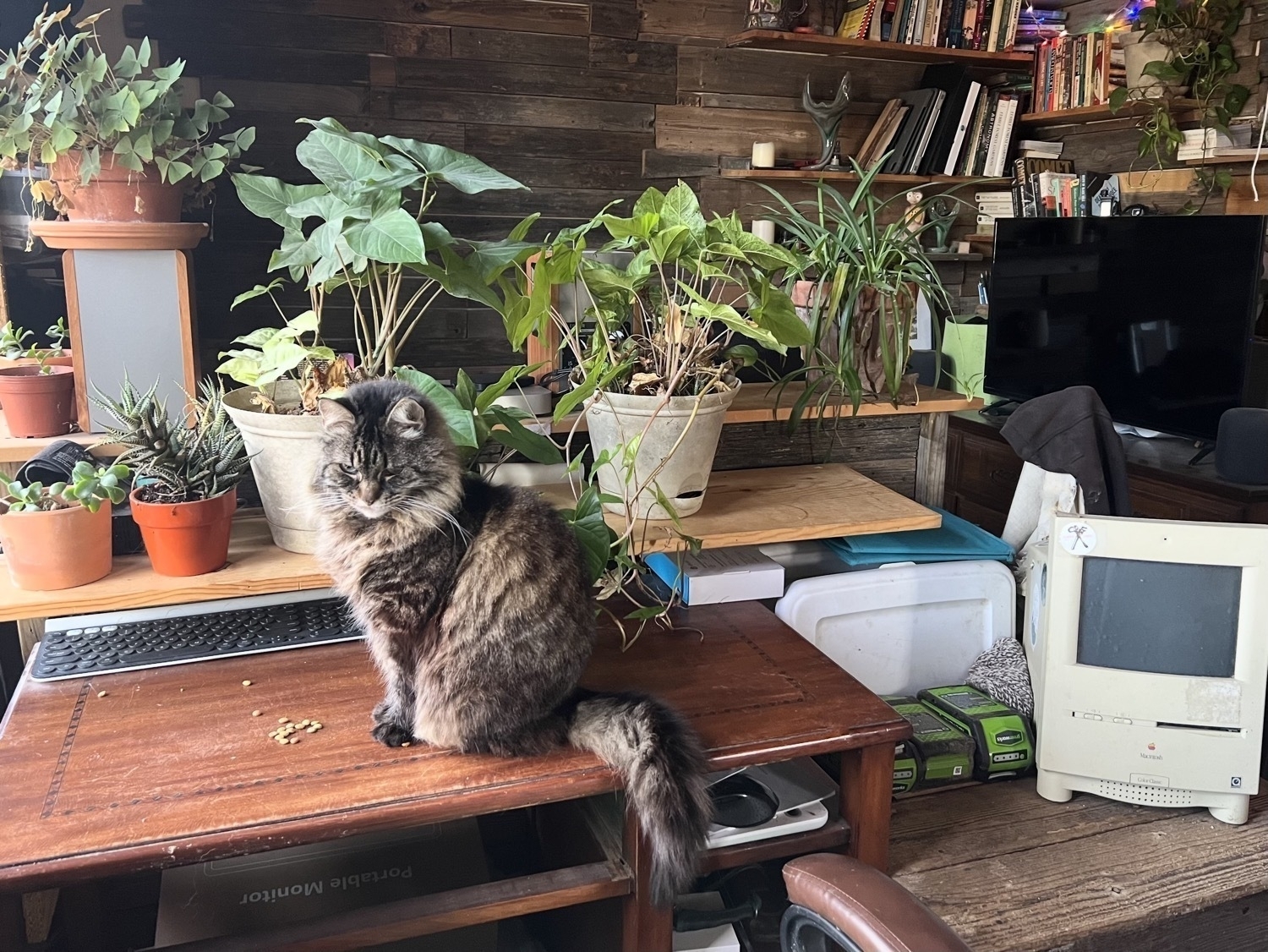
With these changes my small desk has more plants around it and is Rosie's dog-proof feeding area. The Mac Mini that is my file server/iPad back-up is in the same place and can be used with the monitor in its new location. The Mac Mini sits on the shelf/mini-wall between my desk and futon. My whole set-up is a bit weird but I attribute that to the fact that it's a one-room tiny house. It's nice though to walk into the cabin and see plants rather than a computer monitor.

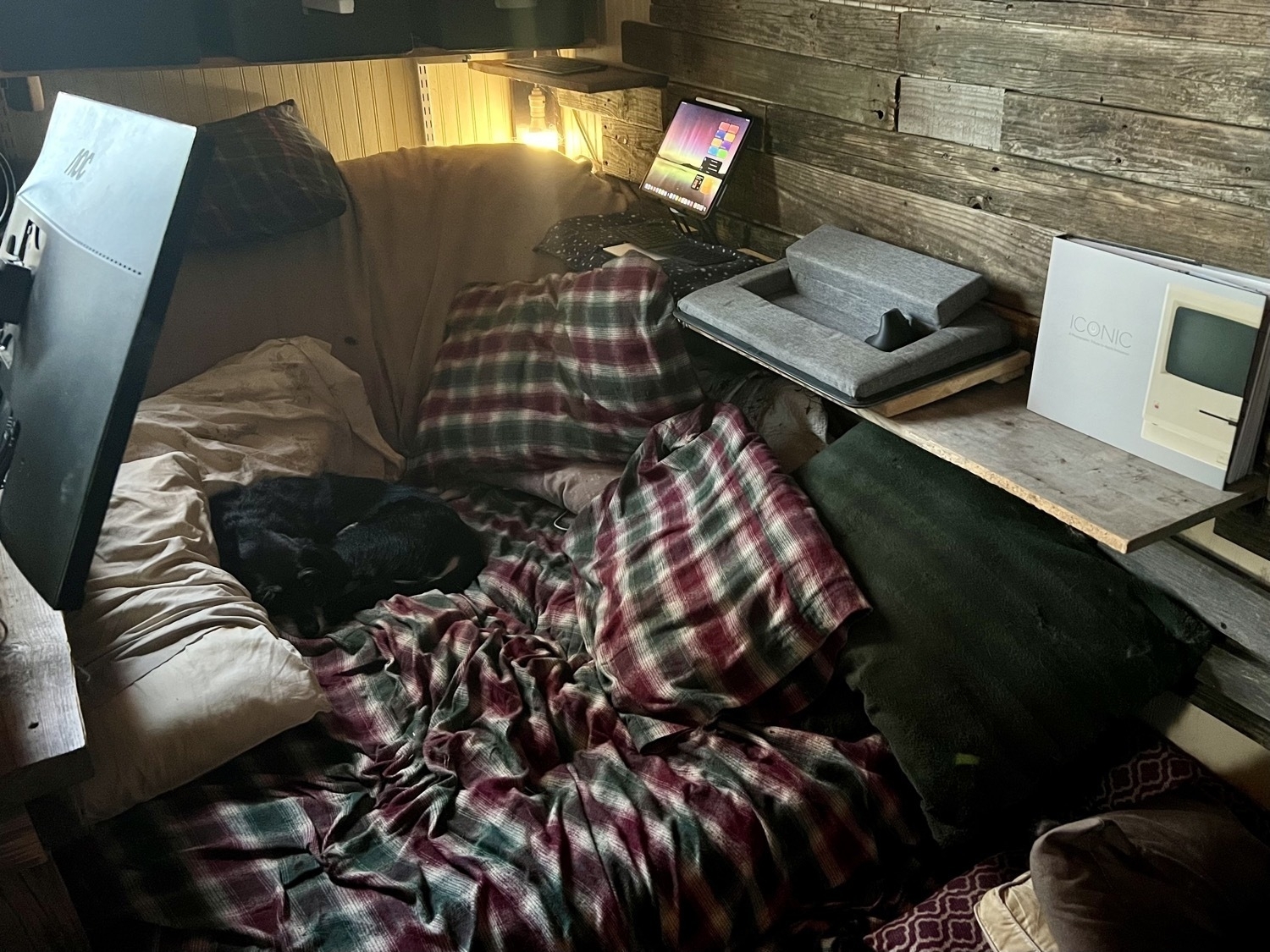 Some amazing iPad hardware is coming from Apple soon but I intend to stick with the M1 iPad as it works very well for what I need. It's only 3 years old this spring. It will likely need a new battery later this year.
Some amazing iPad hardware is coming from Apple soon but I intend to stick with the M1 iPad as it works very well for what I need. It's only 3 years old this spring. It will likely need a new battery later this year.
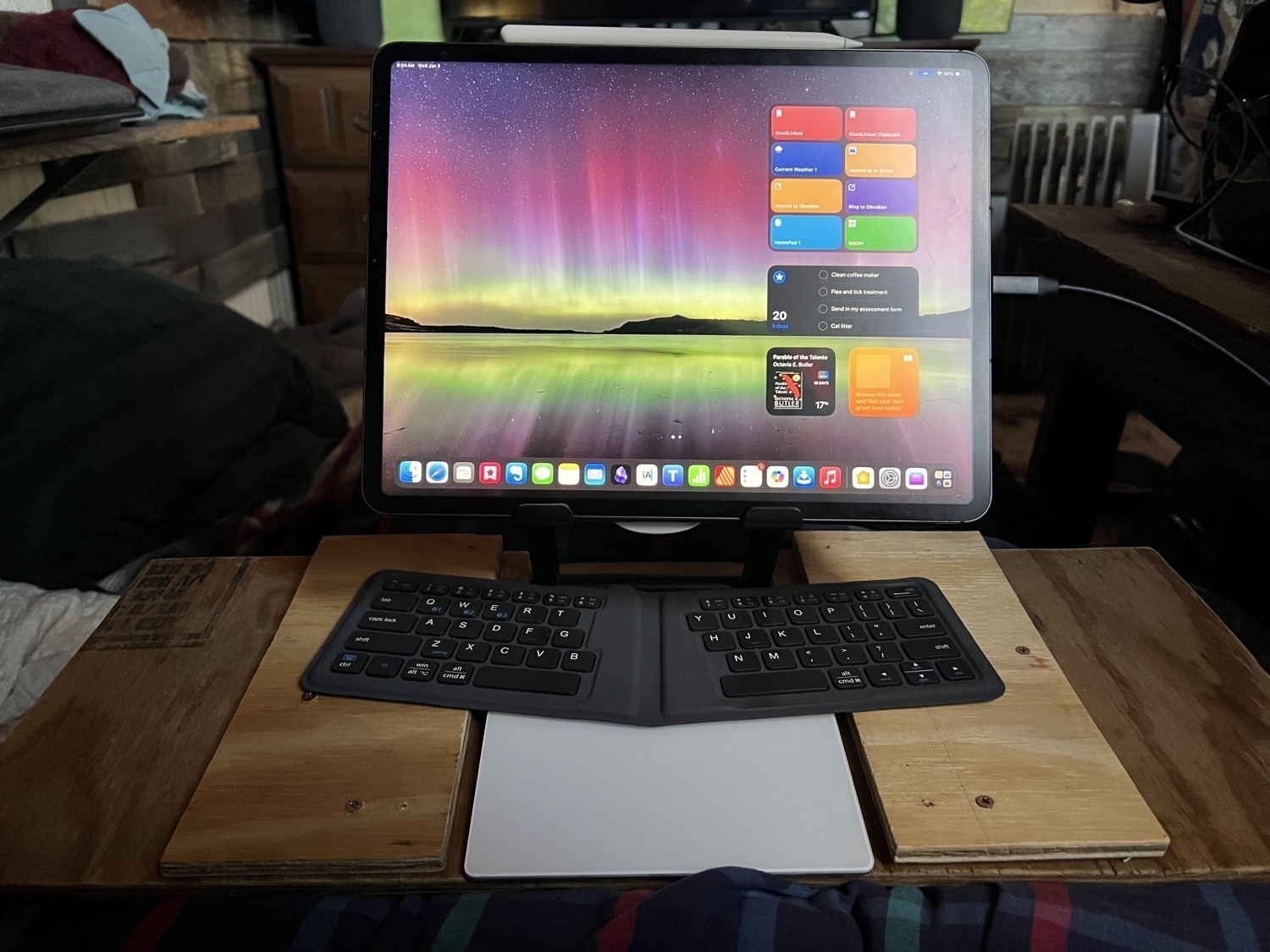
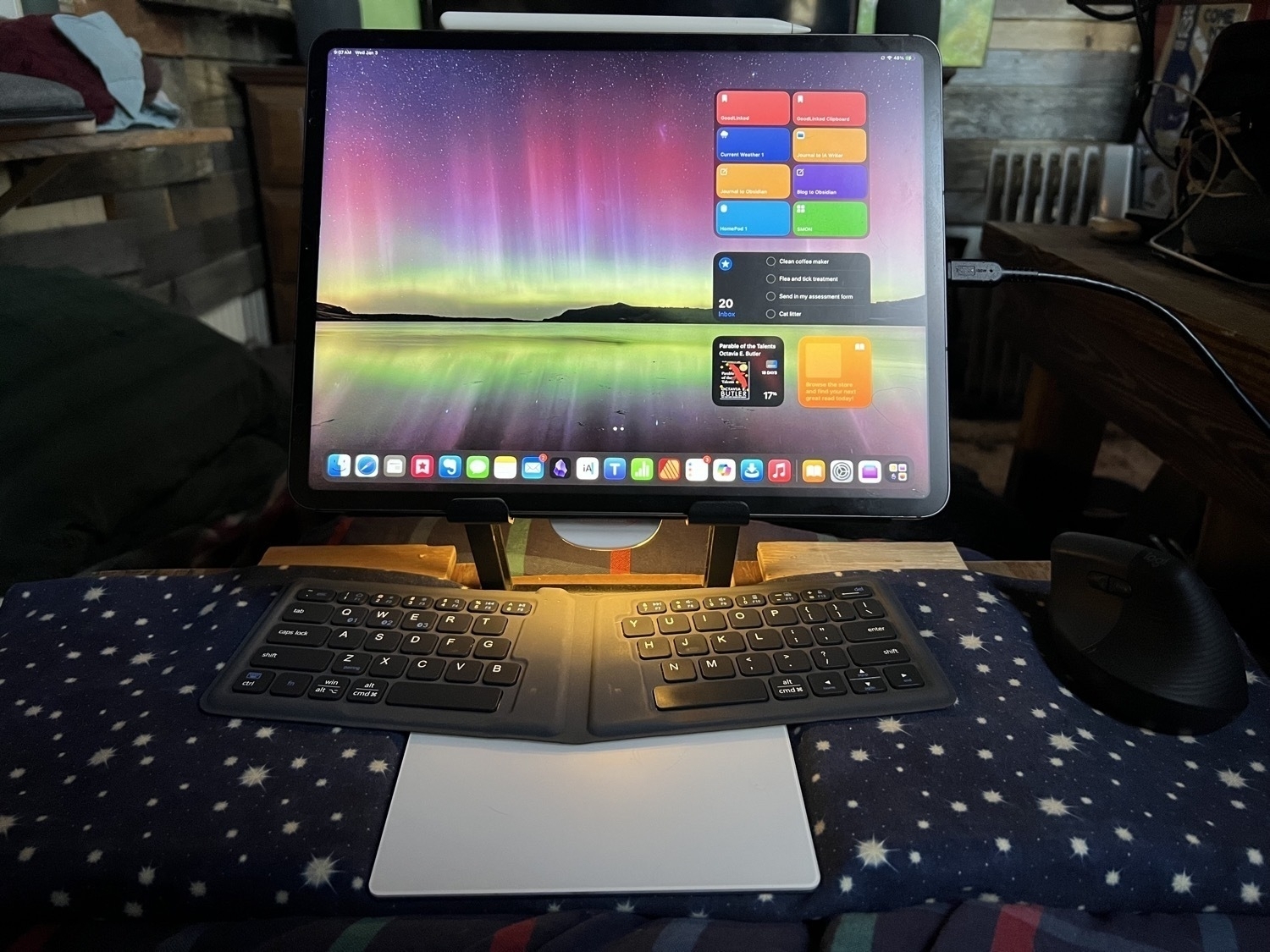
Over the past year I’ve enjoyed my various and ongoing configuration experiments. Just yesterday I modified my lap stand so that I can easily center my trackpad below the keyboard. By adding two small sideboards it’s now a recessed trackpad. Works perfectly and there’s plenty of room for the mouse to the side. In use I keep a pillow case on top for comfort.
Between this stand arrangement and having the adjustable shelf-clamped stand I have a variety of choices. A side benefit of this regular experimentation is that my set-up is fun and never feels stagnant.
My iPad Mini 5 and iPhone 13 both continue to work well and I expect to get at least another 3 to 5 years from both. The responsible thing is to use all of this hardware as long as I'm able and that's the plan. I want to appreciate not just the resources each device embodies but also to appreciate a kind of connection that comes with using a tool for a while. I expect I'll be able to get another year from my Appe Watch 4.
Among tech enthusiasts it seems fairly common these days to trade up to the latest, greatest fairly often. And so these valuable, powerful computers are being treated like disposable goods. Really, it's something that only a minority of the wealthiest and most privileged of humans can do and it's irresponsible. But also, it doesn't allow much room for the nostalgia that comes with long-term use. My 9+ years old iPad Air 2 still works and is put to use to run the DarkNoise app and occasionally for photo slide shows.
All that to say that I've been very happy with the over-abundance of computer/tech hardware that I have.
Image of one corner of the interior of my tiny house, 2024-01-03.

Bread and Circuses: “Sometimes I wonder about justi…” - Climate Justice Social
Sometimes I wonder about justice. People love to talk about it, but in real life how frequently does justice go unmet?
Will adequate reparations ever be made to the millions or billions of people in the Global South who have suffered undeservedly?
And what about the countless plant and animal species who already have been extinguished, gone forever, lost to extinction to feed the greed of man? They have no voice — what could justice mean for them?
#ClimateEmergency #ClimateJustice
Climate Emergency Link Roundup
#ClimateEmergency
The hottest year in recorded history casts doubts on humanity’s ability to deal with a climate crisis of its own making, senior scientists have said.
As historically high temperatures continued to be registered in many parts of the world in late December, the former Nasa scientist James Hansen told the Guardian that 2023 would be remembered as the moment when failures became apparent.
“When our children and grandchildren look back at the history of human-made climate change, this year and next will be seen as the turning point at which the futility of governments in dealing with climate change was finally exposed,” he said.
Amazon drought: ‘We’ve never seen anything like this’
The Amazon rainforest experienced its worst drought on record in 2023. Many villages became unreachable by river, wildfires raged and wildlife died. Some scientists worry events like these are a sign that the world’s biggest forest is fast approaching a point of no return.
Global heating is accelerating, warns scientist who sounded climate alarm in the 80s…
The Earth’s climate is more sensitive to human-caused changes than scientists have realized until now, meaning that a “dangerous” burst of heating will be unleashed that will push the world to be 1.5C hotter than it was, on average, in pre-industrial times within the 2020s and 2C hotter by 2050, the paper published on Thursday predicts … The new research, comprising peer-reviewed work of Hansen and more than a dozen other scientists, argues that this imbalance, the Earth’s greater climate sensitivity and a reduction in pollution from shipping, which has cut the amount of airborne sulphur particles that reflect incoming sunlight, are causing an escalation in global heating.
The Illusions of Fossil Fuels - by Geoffrey Deihl…
We live in an illusion. This illusion has taken place in the blink of an eye. Everything we think of as reality is a mirage, created by the discovery of fossil fuels.
Our minds do a poor job with the concept of time. Consider that the Earth is 4.6 billion years old. Scaled to 46 years, a number we can grasp, human beings have been here for just four hours, and the industrial revolution started one minute ago. In that sliver of time, we have imperiled our survival on this planet.
At this moment, one million species face extinction. Countless others were already consigned to oblivion by our activities. Twenty thousand years ago, humans comprised just one percent of the combined weight of all land vertebrates. Today, we comprise thirty-two percent of that weight and wild animals have been reduced to one percent. The other sixty-seven percent are the domesticated animals we imprison, torture, and eat to sustain our overpopulation. We have outstripped our environment. Any species that does so is destined for collapse.
‘Insanity’: petrostates planning huge expansion of fossil fuels, says UN report…
The world’s fossil fuel producers are planning expansions that would blow the planet’s carbon budget twice over, a UN report has found. Experts called the plans “insanity” which “throw humanity’s future into question”.
The energy plans of the petrostates contradicted their climate policies and pledges, the report said. The plans would lead to 460% more coal production, 83% more gas, and 29% more oil in 2030 than it was possible to burn if global temperature rise was to be kept to the internationally agreed 1.5C. The plans would also produce 69% more fossil fuels than is compatible with the riskier 2C target.
Finished: Parable of the Sower by Octavia E. Butler 📚
I finally read a book in 2023 and I’ve started the second in a series. A light-hearted read about life during the collapse of civilization.
Feeding 8 billion humans in a climate crisis
Something I often note in the ongoing discussion about the climate emergency is that many/most people seem to be underestimating the importance of a steady, predictable climate for the growing of food for 8 billion humans on the Earth. People do not grasp the fragility of agricultural systems nor do they grasp the resources required to grow, process and ship that food to 8 billion humans. It’s not something the media discusses unless it becomes a problem.
I’ll get back to the issue of food production in a moment.
I suspect that for those of us who have been thinking about this for a longer period of time, it’s more of an issue as we’ve allowed ourselves time to play out the details of various possible scenarios. But a large portion of the public have largely tuned out climate change until recently and even now I suspect many just dwell on it briefly, rarely digging into the details. For some it’s only just starting to click that climate change has quickly turned into a climate emergency. And even so, many are only getting that from increasing frequency of headlines and not real investigation into details or thoughtful consideration.
In glossing over the real world effects that are happening now or likely to happen in the not too distant future, many people have just jumped to making statements in which they seem to embrace the darkest possibilities of what’s to come.
It almost seems like until recently the popular opinion was, oh, yeah, the climate is a problem but we’ll fix it with technology like electric cars. Basically, a kind of hand-wavy dismissal. And now, suddenly, the popular consciousness has jumped from casual dismissal to it’s an emergency that it is too late to solve.
In either case the convenient implication is that they have no reason to act. In scenario one of casual acceptance, a techno fix would present itself. In scenario two, ok, we’re now in a climate emergency the shrug-off is well, it’s too late, nothing to be done.
Let’s get back to the question of food production. The past two to three years we’ve seen far more media coverage of the many and increasingly extreme weather events caused by climate change. From wild fires to extended drought to extreme flooding. We’re now seeing the headlines constantly as we should.
But what is too rare are the stories that delve into the real-world implications of these events. Beyond the video of the events or the immediate aftermath, what are the mid and long-term effects? And, more specifically for this post, how is weather affecting our ability to grow food? The food system in general could do with far more attention from the media so that the public understands the full production cycle as well as sources and distribution.
In general the public seems ignorant of how food gets to the shelves of their grocery stores. It’s just assumed that food will be there. The covid pandemic provided a brief glimpse into what a mild supply chain disruption would look like. But that was just a glimpse at a temporary disruption.
Consider some of the variables that can disrupt farmers' ability to produce a crop in any given year. Just a tiny sampling:
- Winter temperatures can impact the ability of fruit and nut trees to reliably produce a harvest. Often referred to as chill hours, a certain number of days below a certain temperature are required for trees to go dormant.
- Late spring frosts can damage or destroy plants or the flowers of trees, bushes or plants thus reducing or eliminating production.
- Too much rainfall in the spring can delay and disrupt when a farmer can plant seed for a crop. Too little rainfall after seed is planted can delay germination. Too much can cause rot of seed or young plants.
- Too much rainfall during the growing season can cause more disease. Too little and plants will die or underproduce.
- Or, a one-two punch, a period of drought followed by a period of excessive rain. First plants are stressed by too little water and then become water logged inducing growth of disease.
- In late summer and early fall when crops are to be harvested farmers need to be able to operate tractors in fields. Too much rain can inhibit this.
The above is just a tiny glimpse of the weather related variables that farmers contend with in planting, growing and harvesting crops. These are problems even when the climate is relatively stable. Global warming is increasing the extremes of drought and flooding as well as reducing the predictability of frost dates, growing zones and is, in general, increasing the probability of lower food yields.
It’s important to also consider that the industrial agricultural system that is the basis of feeding 8 billion humans and is the primary mode of global food production, is built upon a foundation of fossil fuels. Fertilizers and pesticides along with the mechanized systems on fields as well as after harvest processing, shipping, etc. all contribute carbon to the atmosphere.
Not only that, industrial agriculture contributes to the ongoing, catastrophic biodiversity crisis.
Humans v nature: our long and destructive journey to the age of extinction…
Although the debate is far from settled, it appears ancient humans took thousands of years to wipe out species in a way modern humans would do in decades. Fast forward to today and we are not just killing megafauna but destroying whole landscapes, often in just a few years. Farming is the primary driver of destruction and, of all mammals on Earth, 96% are either livestock or humans. The UN estimates as many as one million plant and animal species are at risk of extinction.
It’s the last day of 2023 and we humans are at a crossroads. We’re in the midst of many inter-dependent crises that are leading us to a future that is difficult to imagine and comprehend. Our ability to feed 8 billion humans should no longer be taken as a given and the human population is still rising. Predictably there will be a crash and we shouldn’t act surprised when that crash happens.
Humans v nature: our long and destructive journey to the age of extinction…
Although the debate is far from settled, it appears ancient humans took thousands of years to wipe out species in a way modern humans would do in decades. Fast forward to today and we are not just killing megafauna but destroying whole landscapes, often in just a few years. Farming is the primary driver of destruction and, of all mammals on Earth, 96% are either livestock or humans. The UN estimates as many as one million plant and animal species are at risk of extinction.
Readers have told me they like to build small-scale photovoltaic installations like those that power Low-tech Magazine’s website and office…
This guide brings all the information together: what you need, how to wire everything, what your design choices are, where to put solar panels, how to fix them in place (or not), how to split power and install measuring instruments. It deals with solar energy systems that charge batteries and simpler configurations that provide direct solar power.
For anyone interested in taking personal action on climate change, highly recommend this article. The main point: our understanding of climate solutions are wrong. Let the actual data guide you.
#ClimateEmergency
Your Eco-Friendly Lifestyle Is a Big Lie…
In 2021 the polling firm Ipsos asked 21,000 people in 30 countries to choose from a list of nine actions which ones they thought would most reduce greenhouse gas emissions for individuals living in a richer country. Most people picked recycling, followed by buying renewable energy, switching to an electric/hybrid car, and opting for low-energy light bulbs. When these actions were ranked by their actual impact on emissions, recycling was third-from-bottom and low-energy light bulbs were last. None of the top-three options selected by people appeared in the “real” top three when ranked by greenhouse gas reductions, which were having one fewer child, not having a car, and avoiding one long-distance flight.
The war on Palestine and Gaza: Link Roundup
I’ve fallen a bit behind so some of these are a few weeks old. That said, for the purpose of bearing witness it’s not about the most recent news. I just want to note and share what’s happening.
#Gaza
Dozens of Elderly Gazans ‘Executed’ by Israeli Troops: Monitor
“Alarmingly, however, dozens were targeted in killings and field executions,” the NGO alleged. “These incidents included soldiers shooting elderly people immediately after ordering them to evacuate their homes, and in some cases, executing them just moments after their release from hours or days of arbitrary detention.”
CNN Film Shows Horror of Israel’s War on Gaza… Finally, CNN gets a film crew on the ground in Gaza.
What to know about U.S. aid to Israel…
What the U.S. provides
**Most U.S. assistance comes in the form **of weapons grants, and more than 80% of Israel’s weapons imports came from the U.S. between 1950 and 2020.
- Israel is also given access to the most advanced military equipment in the world, including the F-35 Joint Strike Fighter.
What to know about Israel’s military strength…
Israel has for decades established itself as one of the most formidable and technologically advanced military powers in the Middle East.
Why it matters: With an annual military budget exceeding $20 billion and access to some of the most advanced U.S. military hardware, Israel controls the skies and much of the sea around its territory, and it has superior cyber capabilities.
- The military arm of Hamas has for more than three decades relied on a guerrilla-warfare-style strategy using rockets, snipers, improvised explosive devices and underground tunnels in attacks against Israel.
- The Israeli military has maintained near total control over the borders and movement of people, goods and security in Gaza since 2007.
I’ve long avoided all the “read it later” apps preferring to just get stuff read in Safari but have found I let tabs pile up. New process: send tabs to GoodLinks and then force myself to spend time in GoodLinks to read and blog. I’ll keep a semi-permanent workspace with GoodLinks and Obsidian.
As the world celebrates the holidays Gaza burns
Spent the past few hours reading and watching the most recent Gaza news. While much of the world has been happily celebrating the holiday, the dehumanization and brutality being visited upon the Palestinians has continued, by some accounts the intensity has actually increased.
In two months 10,000 children and more than 20,000 Palestinians of all ages, have been killed.
And if you’re been tuning it out because it’s ugly and hard to watch I’d ask/urge you to not turn away from it especially if you are a citizen of the US. This is the direct result of US foreign policy, being done with US funds and weapons. The least we can do is bear witness to it. That’s the very least we can do. Any mental or emotional reaction we have pales in comparison to what our fellow human beings are enduring every moment of every day.
The US is Israel’s number one supporter and funder and have been for decades. Many decades. All that has been happening there in recent weeks is the culmination of those decades. Thus far it is rightly being described as: war crimes, ethnic cleansing, and in the near future will very likely be classified as genocide.
So while we have been enjoying feasts of food, comfortably visiting with friends and family, they have been going without basic nourishment and being thirsty every hour of every day. Watching the world around them be blown apart. Daily watching people be shot, blown apart or crushed under buildings that have been blown apart.
I cannot begin to imagine the daily horror of it. And so I watch and read to try to witness it. It’s truly the least I can do and only the bare minimum.
We in the US have got to stop turning away from the horror we create in the name of our strategic positioning and security. The citizens of the US turn away from the truth of our foreign policy and have done so for many decades. We live in a permanent state of denial of our violence and our responsibility for atrocities.
We need to own it because turning away from it allows it to continue. Decades of brutality and dehumanization against the Palestinians explain what we see in Gaza today. And by turning away we ensure that it will continue.
#Gaza #WarCrimes
Everything we know about Joe Biden’s 50-year history of supporting and facilitating Israel’s worst crimes leads to one conclusion: He wants Israel’s destruction of Gaza — with more than 7,000 children dead — to unfold as it has. When will it stop? Intercept co-founder Jeremy Scahill and journalist Sharif Abdel Kouddous discuss the U.S. role in Israel’s scorched-earth campaign to annihilate Gaza.
#Gaza #Palestine #WarCrimes #Genocide
A Conversation on the Horrors in Gaza with Jeremy Scahill and Sharif Abdel Kouddous - YouTube
Still no peace in Palestine.
People are desperately searching for survivors after Monday’s attacks by Israeli forces. One man said five of his family members were trapped under the rubble, including his two-month-old child. He said there had been no ambulances or members of the civil defence present since Sunday so he had resorted to digging with his hands. It smells like blood, we see shattered bodies, and we just saw them remove a baby from under the rubble.
#Gaza #Palestine
Many people under the rubble after Israel’s air attacks on central Gaza - YouTube
A gall induced by Atrusca quercuscentricola, Spotted oak apple gall wasp. An egg is laid and after hatching the larvae signals the tree which produces a protective gall which contains a nutritious food source. At maturity in late November to early December it cut's a tiny hole and exits the gall.

The Israeli government is using starvation of civilians as a method of warfare in the occupied Gaza Strip, which is a war crime, Human Rights Watch said today. Israeli forces are deliberately blocking the delivery of water, food, and fuel, while willfully impeding humanitarian assistance, apparently razing agricultural areas, and depriving the civilian population of objects indispensable to their survival.
#Gaza #WarCrimes
Israel: Starvation Used as Weapon of War in Gaza | Human Rights Watch
My current favorite iPad set-up, the work-around-the-cat configuration. My futon, placed on the floor with shelves on both sides in easy reach. iPad is snug in adjustable stand clamped to shelf and floats above pillows in my lap. Rosie is about to take the place of the keyboard.

#Caturday #iPad
Seen on my morning trail walk. From top to bottom: The gall of a Atrusca quercuscentricola Spotted oak apple gall wasp.
Cladonia portentosa Lichen

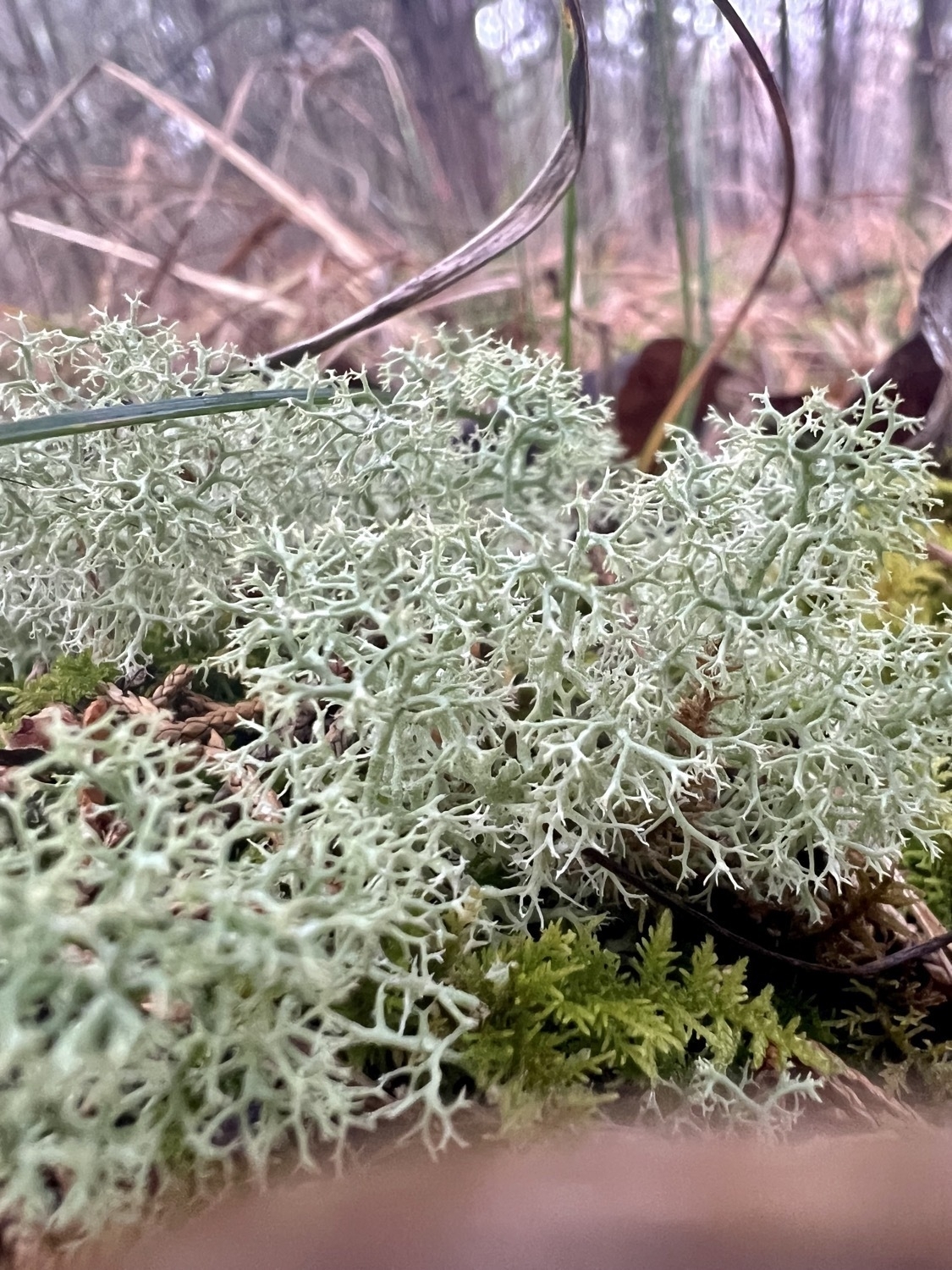
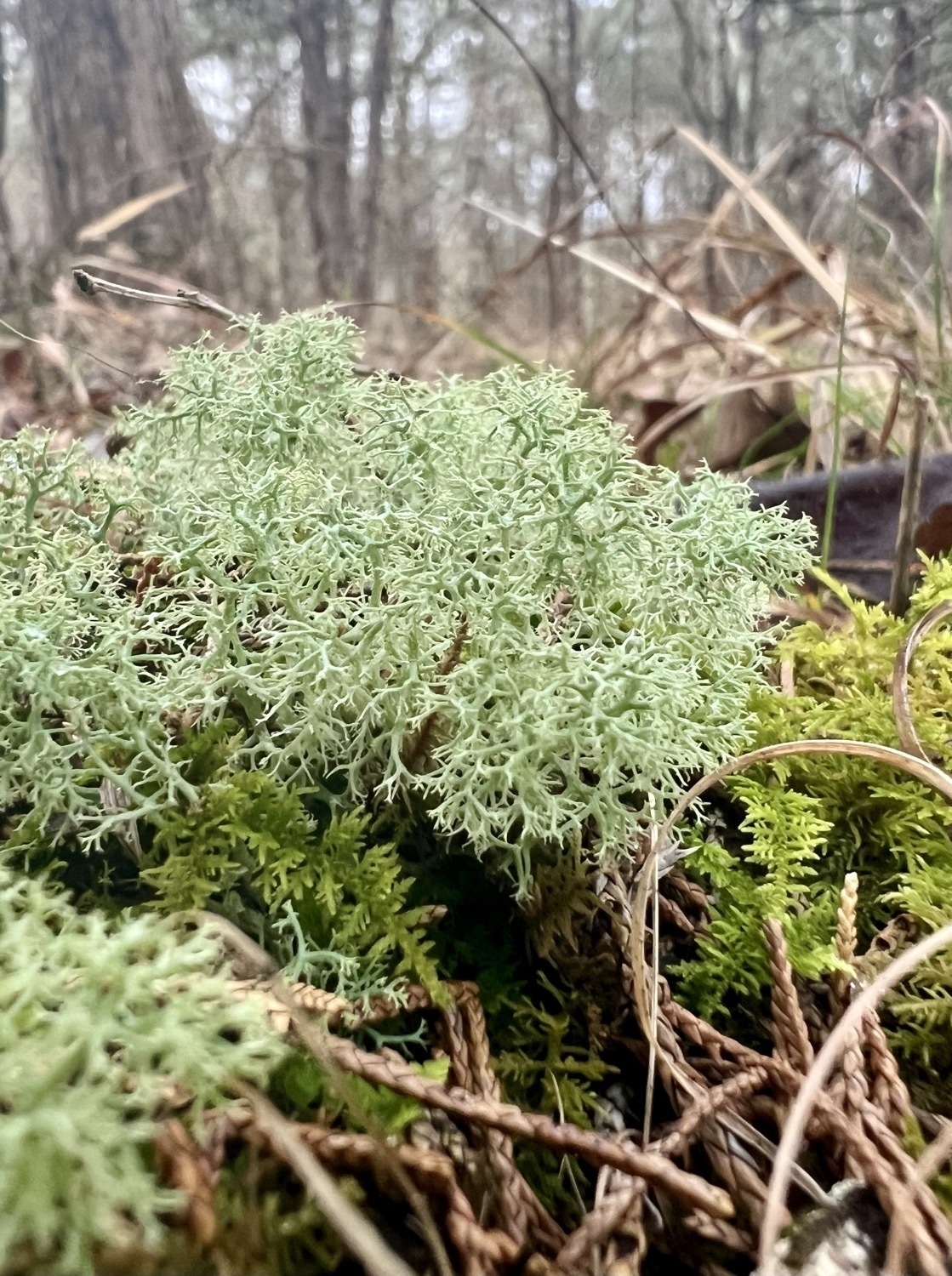
When a government is guilty of war crimes when does its citizenry also become guilty of war crimes? Climate crimes?
When is the citizenry to be held responsible for its inability or unwillingness to check the crimes of its government?
We the people.
#genocide #gaza #warcrimes #climatecrime
Thoughts Micro.blog and it's place in the fediverse
Out on my trail walk this morning I was listening to a recent episode of Dot Social , a podcast about the fediverse hosted by Mike McCue of Flipboard. (Sidenote: Really enjoying this podcast.) In this episode he’s interviewing a co-founder of WIRED, John Battelle. Something in the discussion set my mind to thinking about two recent posts by Manton at Micro.blog, both of which resulted in excellent conversations.
In mentioning recent coverage of the fedivese and ActivityPub Manton wrote:
I don’t mind flying under the radar. There are benefits for a product to start small and grow slowly. But I’m still kind of puzzled why Micro.blog is rarely mentioned when articles talk about platforms that support the fediverse.
As the year winds down, thinking about the fediverse, I want to do a better job in 2024 of making the case for independent blogs. Lots of platforms with thousands of users on each server talking via ActivityPub is great, but more blogs also helps with portable identity and a more distributed web.
I chimed in a bit in the responses to the first post. And similar conversations have been revisited by micro.blog folks often over the past couple of years. Questions about how micro.blog fits into the larger fediverse often followed by folk asking for a variety of features found on Mastodon and other, older corporate social media, namely boosting/re-posting, favoriting and the option for better searching and discoverablity via hashtags.
Thus far these are all features that Manton has repeatedly stated will not be added to micro.blog. And many micro.blog users are satisfied by that decision. But some are not. My ongoing frustration has been that within the micro.blog community I cannot find others with similar interests. Search and discovery are so limited by the human curation of a community timeline that it is basically useless. It will likely remain so given the deliberate limits currently in place.
But I’ve also realized that discovery and search of micro.blog from the fediverse is also completely broken. I think many of us that are excited about having a blog that is also connected to the fediverse assume that there is at least some cross platform search functionality. As far as I’m aware the only search that works is specific username search. The text of posts and profiles is, in terms of search and discoverability from Mastodon, invisible.
And so I’ve been considering the place and benefit of Micro.blog as an ActivityPub service/client. It’s one of several fediverse communities outside of Mastodon but connected to all others via ActivityPub. One of the recurring questions in the micro.blog timeline and help forum is “Can I just use my micro.blog account as my only ActivityPub account?” And the companion question: “Do I also need a Mastodon account?”. The answer is always along the lines of it depends on what you want to do. When compared to the Mastodon experience you’ll be missing certain features. And that shouldn’t be ignored because Mastodon (and older social media) has set the bar and expectations.
So, today, listening to the above linked podcast and thinking about these questions I asked myself, what is it that I really want from an ActivityPub connected blog? How well does the current micro.blog app and website hold up? What is the ideal that I’m looking for? I’m taking the time to write this because I see it come up quite often, often enough to know I’m not the only one.
What I want is a paid, hosted ActivityPub blogging service that offers a website/client app that:
- Allows me to write/publish posts in markdown
- Allows me to follow other ActvityPub accounts
- Lets me organize the accounts I follow into lists based on interests. I do the same with my RSS reader.
- Supports searching tags in posts and users as Mastodon does
- Supports searching of keywords in users' posts.
- Supports boosting, favoriting of others' posts as well as viewing boosts/favorites of ones own posts
Micro.blog has no problem with the first two but falls flat on the last 4. Due to the limits of search within the micro.blog community timeline I’ve largely accepted that it’s not for me. And I’ve confirmed that my site is properly indexed by search engines so that’s not an issue. I can add hashtags and will start doing so to all my posts going forward will be more searchable in the Fediverse. It’s something that’s frowned upon by many micro.blog users because it’s “unsightly” and clutters up the timeline. Frankly, that’s not a take I agree with. It’s a degradation of function and search. And search on micro.blog is already terrible.
Which brings me to the next point, whatever is going on behind the scenes, posts hosted at micro.blog are not indexed or searchable in the larger fediverse. If hashtags are added they do seem show up as expected. But just doing a keyword search provides zero results from Mastodon accounts.
The end result is that as a micro.blog user I know that my blog is connected to the fediverse and yet it’s only a partial connection. I can function within the fediverse, but only half way. Yes, I can find, follow and engage with other fediverse folk with comments. A big thanks to Manton on this because to my knowledge there is no other blogging platform that has this level of ActivityPub support. Write.as offers blogging and ActivityPub support but does not support commenting. WordPress has a plugin but the last I tried it was less than optimal and had far less functionality.
But the culture of the fediverse includes boosting and showing appreciation with favoriting/liking and I miss out on all that. Those are real interactions that just disappear for micro.blog users. They’re not even an option. It feels like a high-minded, ethical choice that I’m subjected to.
What perturbs me is that it just feels like stubbornness to not offer as options some of these features that are considered by many to be core features. A choice and limitation is made for me based on values that are not mine. It’s a degradation of user experience that causes more friction as it requires me to have a second ActivityPub account at Mastodon. Which is to say, it feels not just limiting but somewhat broken.
And that brings me back to Manton’s posts linked above. I know and appreciate that Manton has worked hard to make micro.blog a first class citizen of the fediverse with full ActivityPub support. He was on it from early days. I know he has plans to improve that support. Based on his recent posts above it seems he thinks there’s still room for micro.blog to grow and that it deserves more recognition for its ActivityPub support. I don’t disagree. But I do think that at least some new users and journalists that spend time getting to know micro.blog as an AcivityPub client will rightly question the lack of features that many expect. And I think it’s a safe assumption that there are users that don’t stay on micro.blog because of these misses.
I plan to stay because the hosting is good and because I know that Manton deeply cares about and loves blogging. It’s easy to see. Manton and micro.blog perfectly demonstrate a slower, more human and social web. But a part of the social web is, you know, to be social. For some that is a comment. For others it’s a quick “favorite” and for still others it’s a repost/share. Not knowing when people have done those things means I’m in the dark about possible connections.
Let me underscore a thought here: there are people on the other side of those non-comment interactions. People that are expressing appreciation, thank you or wow, I like this enough to share it. Manton and others here seem to have a cynical take on these things. And I get that Facebook and other corporate social media have set a precedent for a kind of crazed, out of control, keep them hooked on the likes dopamine fest.
But the flip side of this is that I’m missing connections with people that might mean something. It may be that such shows of appreciation are from people I might be interested in getting to know. On Mastodon when someone likes a post or reshares it or follows me I go to see who they are. And often I find someone that interests me. I follow them back and am now regularly interacting and conversing with several people that I likely would not be if I had relied on my Micro.blog account as my only fediverse account.
Republican front-runner Donald Trump is escalating his racist rhetoric, repeatedly saying in recent days that immigrants are “poisoning the blood of our country,” drawing comparisons to Hitler. Journalist Jeff Sharlet explains Project 2025, an agency-by-agency plan backed by a coalition of conservative groups for implementing fascism if Trump regains power, and how the former president is giving the far right the national stage they’ve always wanted.